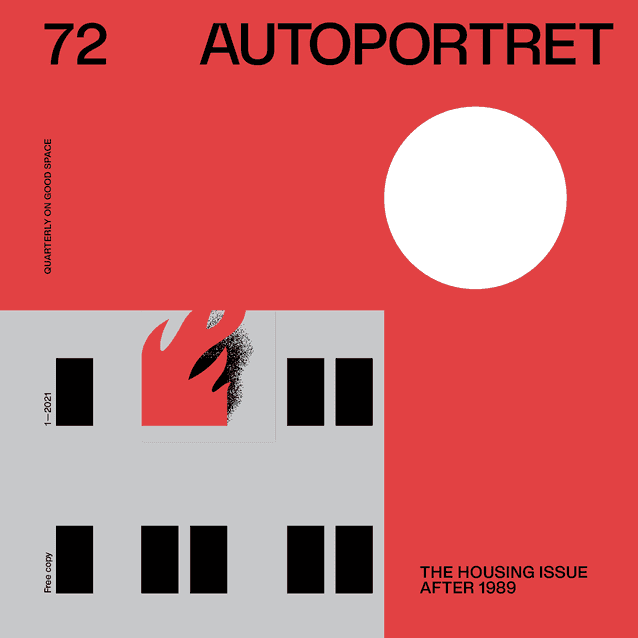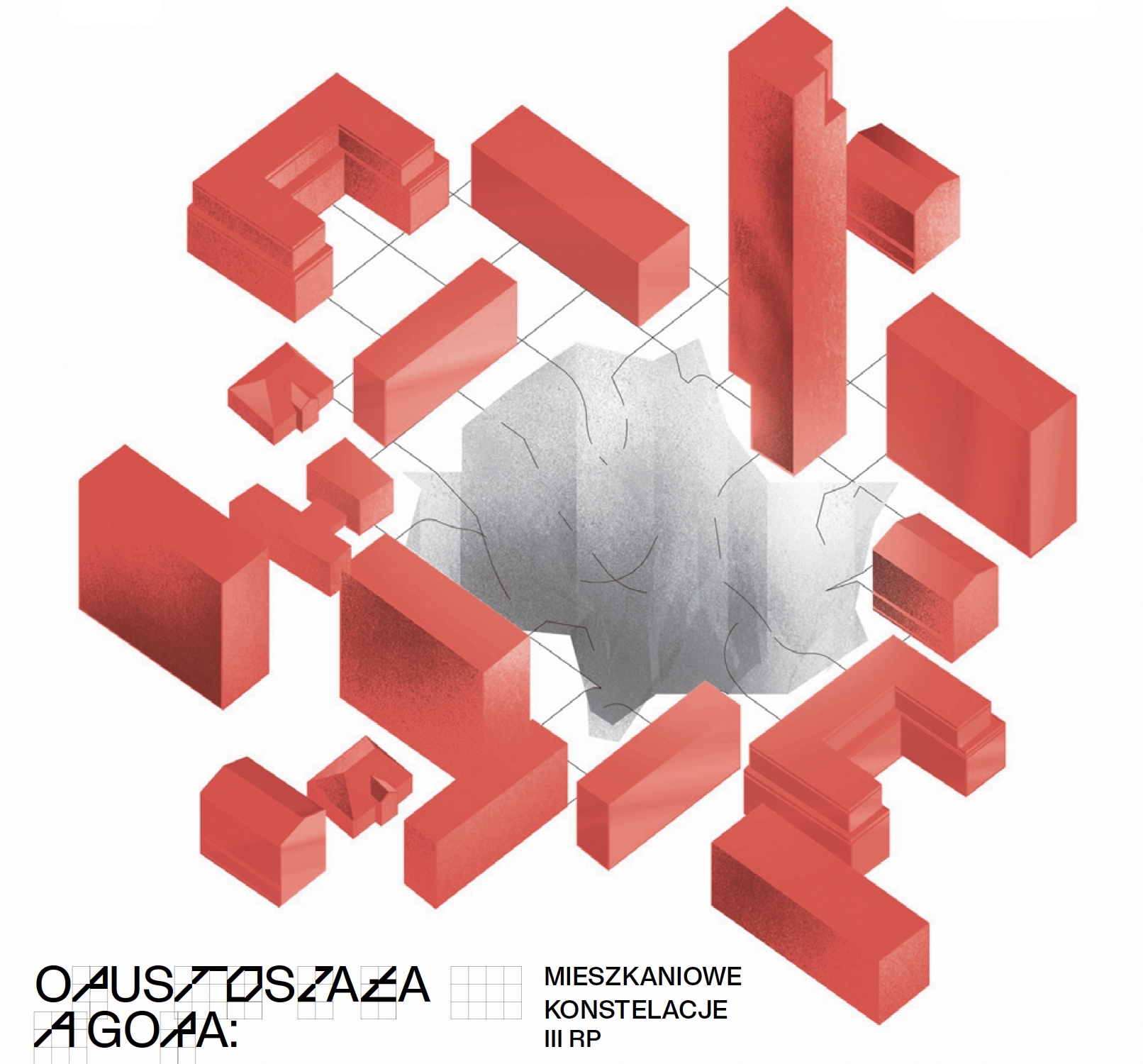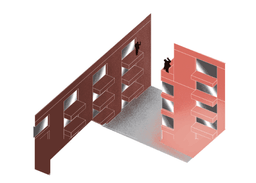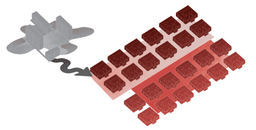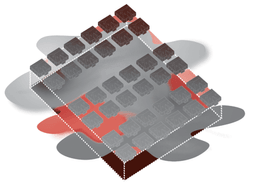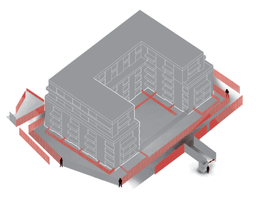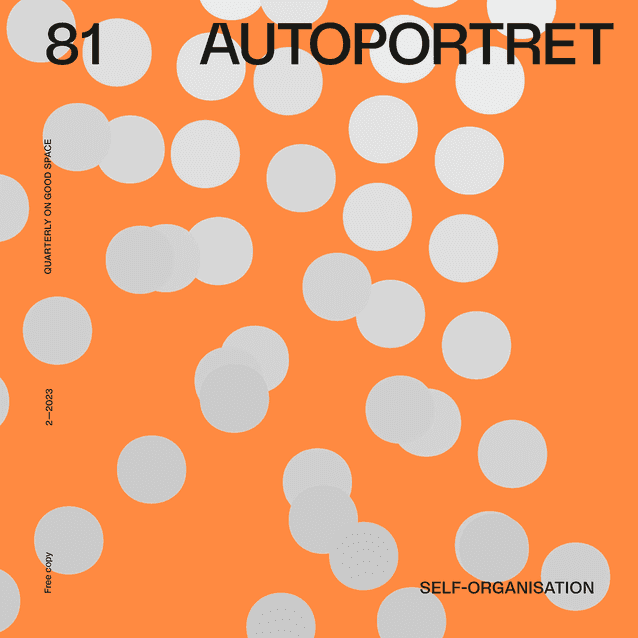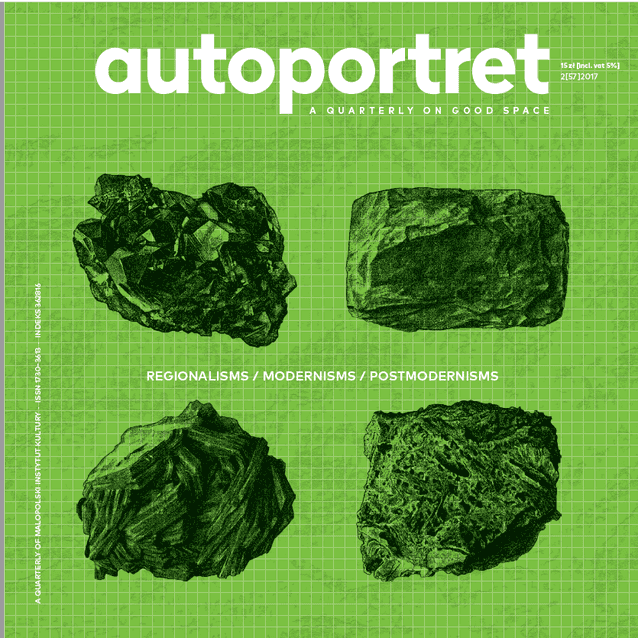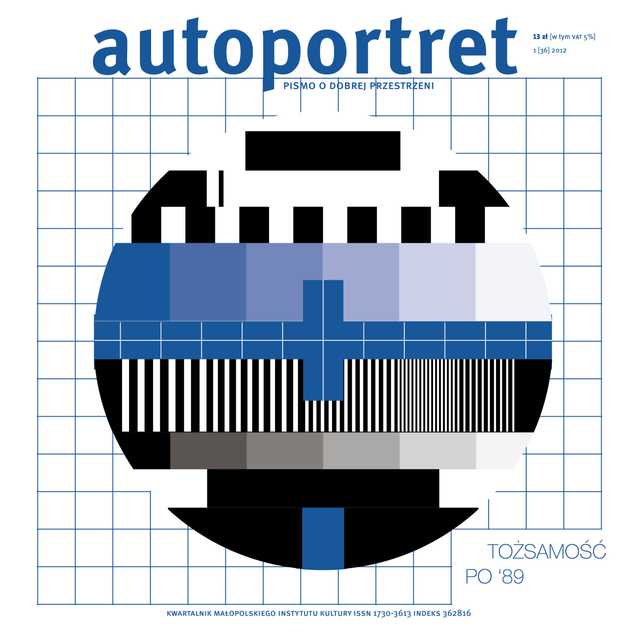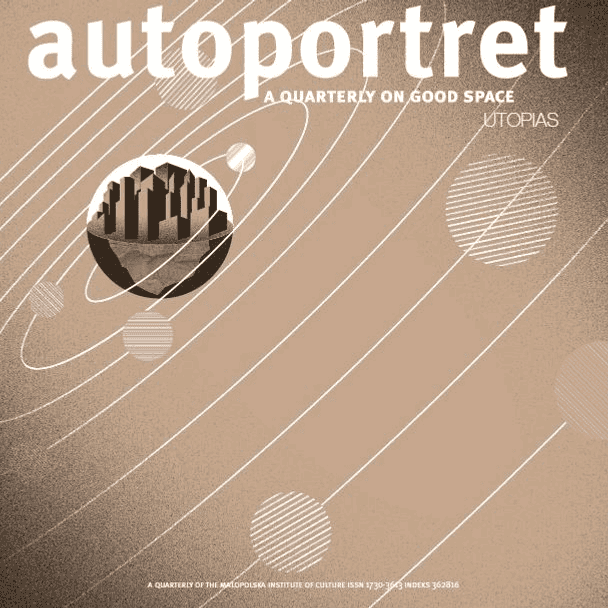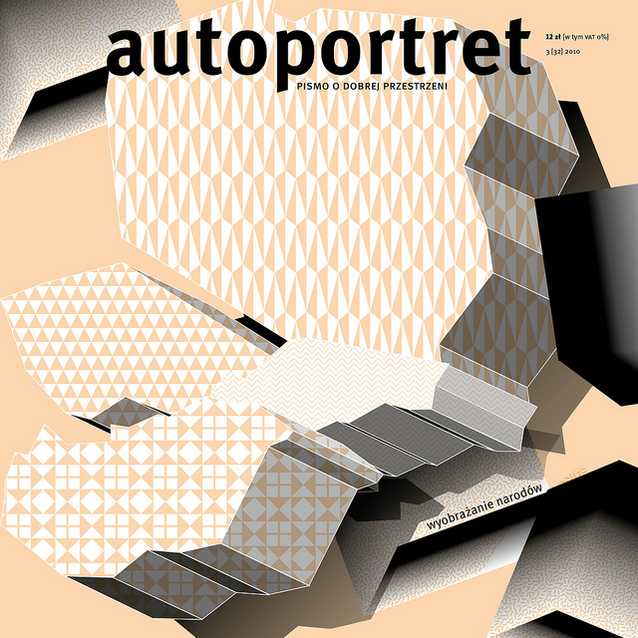He looked around, about him, on the fence, at the well, at the guava tree, and everything, and it occurred to him that this compound had been part of him. He would live on from this moment like a living animal of the present whose tail is stretched permanently into the past. It was this thought that broke him the most, and which caused him to weep as Elochukwu, who would be handing over the keys of the house to the new owners, locked it all up.1
The dwelling – house or apartment – although undoubtedly separated from the surrounding space by a solid structure of walls and ceilings, goes beyond the original framework of physical shelter and fulfils a fundamental function in human life. As sociologist and city activist Joanna Erbel argues, our dwelling determines our initial situation, as it determines opportunities, or becomes a source of limitations.2 The way in which we manage to meet our housing needs determines other life strategies – it influences our decisions about taking up a job, starting a family, or pursuing education. It regulates the rhythm of everyday life, based on a specific routine of necessary habits and behaviours. It can become an eloquent element of self-creation or, on the contrary, an allegorical cage from which we strive to escape – a lesson that many of us learned the hard way during the pandemic. All the while, the material shell of the apartment is covered with a dense web of personal meanings and associations assigned thereto, memories of moments spent with loved ones, emotions we experienced. Despite the multidimensionality of the issue, Poles have become accustomed to considering it in terms imposed by the neoliberal dogma, which reduces housing to economic parameters, dictated not so much by the actual costs of shaping the housing environment, but by the imperative of profit. As a result, the selling price per square meter has become the most sacred indicator describing the home.
The fundamental metamorphosis of the Polish housing system has, of course, a transformational pedigree and is an expression of not only political and economic changes, but above all, of social changes. The modernity that was crystallizing in the 1990s in the West, which the Third Polish Republic was hastily trying to catch up with, was described by Zygmunt Bauman as liquid modernity. According to Bauman, the latter replaced the historic stage of early, “solid” capitalism, directly derived from the industrial revolution. Its symbols featured Fordist factory, bureaucracy, Panopticon, Big Brother, and finally, the Konzlager.3 This epoch was haunted by the dangerous spectre of totalitarianism, summarized in Orwell’s canonical 1984, and in Polish literature, for instance in Witkacy’s Szewcy (The Shoemakers) or Pożegnanie Jesieni (Farewell to Autumn). Predominant fear concerned the defencelessness of an individual, melting into the homogeneous mass of society and losing autonomy in confrontation with a centralized political system. The emancipation of man from the reality filled with threats became a historic turning point; it opened the way to a new order, which to a greater or lesser extent began to be guided by Margaret Thatcher’s infamous maxim “There’s no such thing as society.” In the ethical and political discourse, utopian visions of a just society began to be displaced by new goals focused on the individual and his never-ending identity project. The modern condition of “continuous transgression” turned out not only to be devoid of faith in gaining control of the future – and thus a goal that would be worth striving for – but also lacking the support of a community of people heading in a similar direction. The fragmentary nature of the world and the indeterminacy of the individual resulted in anxiety, as well as loneliness in facing life challenges. Furthermore, Bauman concludes, individualization is not a choice but a human fate, and the independence or self-sufficiency of the individual is yet another illusion.4 Thus, freedom has a bitter aftertaste of appearances, because we did not choose the circumstances in which we are faced with our choices, and we probably have no influence upon those either.
What is truly disastrous for a good housing system, though, is not so much the existential dilemmas of individuals as the accompanying breakdown of the idea of community. The individual is the citizen’s worst enemy because the citizen “is a person inclined to seek his or her own welfare through the well-being of the city – while the individual tends to be lukewarm, sceptical or wary about ‘common cause’.”5 Bauman’s concerns are shared by the American philosopher and historian of ideas, Mark Lilla. The latter criticizes contemporary liberal politics for giving up inspiring people to actively transform society in favour of the passive, social construction of individuals: “In an age when we need to educate young people to think of themselves as citizens with duties toward each other, we encourage them instead to descend into the rabbit hole of the self.”6 The individual pulled into an identity project, out of momentum ends up occupying a position in the culture war in which “what is being said is much less important than who wants to speak and for what reason”.7 Michał Markowski, literary critic and essayist, explains that the direct consequence of “aggression of opinions, emotions, and values” is progressing polarization, because the dividing line today runs in a horizontal, level relationship, between contradictory world views of voters, rather than vertically, bottom-up, that is, between society and those in power.8
When postmodernity reached Poland, a backward country in relation to the West, it fell on fertile ground in a society tired of the People’s Republic and resulted in a wide-ranging “manifestation of long-suppressed individuality”.9 In this article, I will try to summarize the legacy of the transformational restructuring of Polish housing, classify its most important trends, and also show that housing and the debate about it as a particular, indispensable good may spark broader, positive changes, addressing further social stratification.
Privatization of profits, socialization of losses
At the root of contemporary living trends lies the transformational reshuffling of roles and values. Satisfying housing needs is now the responsibility of a modern – and therefore self-sufficient and independent – individual, rather than of the social policy by the State, as the latter gladly relinquishes control tools in this area. Inseparable from this phenomenon is the final ennoblement of private property, equated with security, and seen as a symbol of individual resourcefulness. As a result of this re-evaluation, and the ensuing political decisions made in the 1990s, Polish housing can be described by three aspects that determine it most powerfully: privatization of virtually all housing sector, largely based on mortgage loans; changes in planning regulations – by which ownership of a plot of land becomes tantamount to the right to build10 – and lastly, the reduction of public funds allocated to housing, down to 0.08 per cent of GDP, which is five times less than the European average.11
According to the formula that the World Bank developed in 1990 in the document The Housing Privatization Model for Central and Eastern Europe, the reform of financing the housing sector and the privatization of municipal resources were prescribed to heal the new democracies. Access to property was treated as a manifestation of Poles’ empowerment in the new economic reality.12 Simultaneously with the process of enfranchisement, came the fixed pattern of an idyllic single-family house among nature; already in the 1980s it slowly evolved from the “Polish cube” towards a “suburban manor”. As a result, in 2011, private housing made up nearly 80 per cent of the total stock. Just over 10 per cent was under public control, and only a few per cent remained within the social housing sector.13
The inevitable consequence of seeing the purchase of a home as the only correct strategy is the generation burdened with twenty or thirty years of mortgage loans. Its representatives often equate signing a loan agreement with true maturity. “For all those who are grown up enough to have their own apartment, PKO Bank Polski offers a mortgage loan at an interest of 1.1 per cent for the first year” – announced the PKO Bank advertisement in 2011.14 Meanwhile, although in the contemporary global economic order credit is undoubtedly an important tool enabling the achievement of housing and other goals, it is often associated with a significant restriction of freedom in making life decisions. It may even become tantamount with being trapped in a specific personal or professional situation, stable but not satisfactory enough. The discipline imposed by the bank loan is also controversial in a broader, social dimension. According to the anthropologist Kacper Pobłocki, “it is a blurry line between loaning in order to increase the availability of housing and make life easier for millions of people, and the moment when the debt mechanism becomes an instrument of exercising power.”15
The basic problem in the Polish housing system is not the bank loan in itself, but its unquestionable inevitability – due to the lack of other options, such as institutional rental, lease with pursuit of ownership, or affordable housing – and its long-term nature, caused on the one hand by insufficient purchasing power of Polish wages on the housing market, and on the other hand, the dominance of this market by private entities driven by return on their investment. All the choice that the free, autonomous and self-sufficient individuals are left with is to choose their relationship with the necessity of debt: either he or she will believe in credit, or feel condemned to it. In addition, this dubious luxury can only befall the richest Poles, about 20 per cent of the population, most of who will not buy a flat for cash, but will “accomplish” creditworthiness.16 Bank loan also becomes an obvious choice due to the deregulated and completely unprofitable rental market. If it is within your reach, it is better to pay your instalment than someone else’s, especially since the character of the lease agreement is not that of a partnership, and your freedom and comfort of living – from the decor to long-term security – depend on the owner’s whim. Adding to that the typically poor condition of the offered apartments, it is no wonder that only 4.5 per cent of Poles decide to rent their flat on the open market.17
People falling into the so-called rent gap are even worse-off: they earn too little to achieve creditworthiness, but too much to be able to apply for social housing or other form of support from the State or local government. According to estimates, the problem affects 30-40 per cent of the population.18 Also worrying is the high percentage of young Poles between the ages of 25 and 34 who still live with their parents. Eurostat data shows that this concerns as many as 40.5 per cent of this age group.19 In the neoliberal model, the risks, contradictions and obstacles are still a product of society, and yet the responsibility and necessity to deal with them are transferred to the shoulders of individuals.20 As sociologist Mateusz Halawa explains, as a result, “housing classes” developed, replacing traditional social classes,21 and belonging to those is associated with the way in which we deal with satisfying our housing needs and, as a result, the way we live.
Dorota Leśniak-Rychlak mentions spatial implications of new forms of living in her book Jesteśmy wreszcie we własnym domu [In our own home, at last]. These include: a gentrified tenement house, a modernized block of flats, a suite in a gated community, a house in the suburbs, and a suburban residence.22 The sociologist Joanna Kusiak explains that their unrestrained proliferation in the city and beyond – the mythical visual chaos – is not a phenomenon of unknown origin, but a manifestation of the installation of neoliberal order, an expression of the logic of capital’s operation in space.23 The key factor in this process is the freedom with which these paradigms can be implemented, resulting from the practical abolition of the role of an urban planner; from gaps in the local master plan; from lack of not only the will, but also of strategies and tools that would enable local governments to supervise the partnership with the private party, while securing the public interests they represent. Therefore, newly emerging housing environments take the shape of dysfunctional neighbourhoods that either sprawl into uncontrolled suburbs or create fenced-in enclaves within the urban fabric.
Out-of-town suburbs are organized along extensive tracts of single-family houses American style: without social infrastructure, that is without public spaces for the local community, without small service centres, workplaces, kindergartens or schools – a roadside grocery store is considered the pinnacle of functional possibilities there. This reprehensible arrangement has become part of the canon of common expectations – since we live far away from the city centre, it seems natural that everywhere and everything is remote. In the dream of a suburban cottage, “time is reduced to one moment, which is a Saturday afternoon spent with young children in the garden, playing with the dog or having a barbecue together”; in this idyll, “the children will never grow up, and the weekend will not turn into a tedious working day marked by arduous commute,” notes Joanna Erbel.24 Say what you will about the post-transformation aspirations of Polish people, additionally stimulated by television clichés; with rising housing prices in the city centre, expanding one’s living space turns out to be economically feasible only in the much cheaper suburbs. This form of living – and with it, developers and banks – was also supported by the State in its few interventions – for example, as part of the Mieszkanie dla Młodych [Flat for the Young] program, it offered loan subsidies, but only up to a specific, low price per square meter.
Dorota Leśniak-Rychlak explains that the move of more enterprising or better-off social groups to new living spaces – whether a house in a green suburbia or a gated estate within the city – has become a way of actualising “the conviction of middle-class representatives about achieving success and wealth through their own talents and work”.25 Since, according to the concept of a resourceful individual, private property in the housing sector both motivates and attests success, developers quickly understood that separating new estates from the urban fabric would increase their value. In Poland, statistically, there are significantly fewer robberies and thefts than in many other countries within the European Community.26 The obsessive construction of wire mesh fences – which by the way are easy to climb over – is on the one hand a marketing trick based on the commodification of fear, and on the other hand, an expression of the nouveau riche prestige associated with the place where such “problems” as “people walking by the windows”, “bums loitering”, or “drunk students returning home at night” have been eliminated.27 We are slowly bidding farewell to fences thanks to the new landscape laws, written in the belief that the city should be a common platform, a place to live and meet various social groups, with a structure allowing for free movement of people.
The fence is the tip of the iceberg of problems stemming from closed housing environments with gentrifying potential. Already at the marketing level, private investors strictly define their target, and by doing so, they do not eliminate social differences, but simply manage them effectively. An advertisement on the website of one of Warsaw’s property development companies claims that the new housing estate is being built “for people who are open minded, who value independence and want to taste new things.” Such messages are part of the contemporary tendency to define one’s identity through “disproportionate and mutual alienation of one’s own uniqueness versus everyone else’s.”28 The ubiquitous alienation is aggravated by the insufficient quantity and quality of common spaces, places of accidental contact, and even children’s playgrounds.
However, this is not about creating an illusion of being-together, but rather about “redesigning and repopulating the now largely vacant agora – the site of meeting, debate and negotiation between the individual and the common, the private and public good.”29 Forty years before Bauman, Hannah Arendt brought this discussion to a deeper level by describing the constitutive aspects of vita activa:
Action and speech create a space between the participants which can find its proper location almost any time and anywhere. It is the space of appearance in the widest sense of the word […] where I appear to others as others appear to me […]. No man, moreover, can live in it all the time. To be deprived of it means to be deprived of reality […]. To men the reality of the world is guaranteed by the presence of others, by its appearing to all […] and whatever lacks this appearance comes and passes away like a dream, intimately and exclusively our own but without reality. 30
Neither Bauman, in invoking the agora, nor Arendt, when writing about the space of appearance, meant physical space. Architects often forget that communities do not appear just because we have provided them with adequate spatial conditions; after all, their existence does not depend solely on space. This does not mean that designing common, public spaces is futile. They are just one of the components needed. Of course, in the end, the agora is a physical structure – a plaza.
Nonetheless, a debate and action should develop over the issue of space, and living space in particular, which is equally relevant to us all. Understanding the specificity of the good that is indispensable to everyone, such as a dwelling, would set a new, supra-individual goal: the right to housing. This essentially solidarity-based proposition is rooted in the belief that ensuring decent living conditions for all members of society is not only at the heart of balancing equal opportunities, but will prove beneficial for the further development of the community, including its economic aspect.
In Article 25 of the UN Declaration of Human Rights, housing is made part of the “health and well-being” standard of living to which every person is entitled.31 According to this assumption, a responsible housing policy must focus on the availability of housing as one of its goals, in addition to the number and quality. Although neither adequate quality, nor even the number, can be ensured solely by market forces, it is precisely the accessibility – especially understood as affordability, i.e. cost below 40 per cent of a household’s income32 – that simply cannot be realized in a free market reality on its own accord. The European Parliament, in a resolution adopted at the beginning of 2021, also calls on the Member States to ensure universal access to decent housing.33
According to the division proposed by the architect and researcher Agata Twardoch in her book System do mieszkania [Housing system], the shaping of accessible housing, apart from intangibles, is influenced by organizational factors – top-down and bottom-up – as well as spatial factors related to the architectural form and location. Top-down, systemic organizational measures resulting from the policy of the State or local government include, for example, elements of fiscal policy (tax breaks), supply policy (council housing and social housing), demand policy (housing loan subsidies or preferential loans), and rent control. Bottom-up instruments are related to the potential of self-organization of groups of people; these include small housing associations, construction groups, and cohousing. In spatial terms, this is about specific architectural solutions, including structural ones, as well as location aspects related to the interactions between the dwelling and its surroundings.34
A good housing system, oriented towards increasing accessibility, would be based on the flexible use of various methods and tools, within a coherent plan covering all levels of administrative organization – at the State, regional, and municipal level. However, I would like to focus on describing two selected strategies: grassroots cooperatives, and prefabricated housing systems (the latter concern spatial activities, as I believe them to have the potential to change the individual perspective into the community optics, shaping civic attitudes, and setting bold social goals).
Second birth
The history of the cooperatives in Poland started promisingly in interwar Warsaw, with the establishment of the Warsaw Housing Cooperative and the Society of Workers’ Housing Estates. Alas, these first attempts to ensure a fair housing environment were interrupted by World War II, and the ideals of the movement’s pioneers, picked up by the communist authorities of the People’s Republic of Poland, were completely distorted in the new political order from the moment the decision was made to manage them centrally. This is the reason why today they do not evoke positive connotations, and modern forms of cooperatives or cohousing are treated as curiosities with no potential for wider dissemination. It is not difficult to imagine a defeatist argument based on the belief that no one will want them in Poland, or that developer housing estates are convenient and, above all, ready-made solutions, and that Poles are busy people who do not have time for this.
My belief is that it is the lack of awareness of the benefits of such solutions that is working against the creation of small, grassroots housing cooperatives. The blame for this state of affairs lies with the promotion of the one and only “correct” model. The convincing narrative of loans and apartments in a commercial development largely draws its strength from the lack of alternatives. Meanwhile, a cooperative initiative has the potential of being much cheaper, and therefore attractive, especially to those who fall within the rent gap. You will still have to take out a loan to cover the investment contribution and its subsequent costs, but it will be a much lower one, because the payment of the developer’s profit and overheads that includes sales offices, agents and marketing will not be added to the cost of building the apartment. The difference becomes significant when you take into account high developer margins, which have remained at the level of 20–30 per cent for several years.35 If local governments were to recognize bottom-up housing initiatives as something positive, they could support cooperatives, for example by selling plots at preferential prices, which would contribute to further cost reduction.36 Building with their own housing environment in mind, the cooperatives would be able to define and meet their expectations regarding the quality of private and shared spaces. As a grassroots group, they would become the seeds of the neighbourhood community.
It should be stressed that a strong local government is needed in order to properly finalize the process of creating a new residential district, taking into account various actors. It is the local self-government that should be setting housing standards and provide the urban plan for the estate – selected in a competition – under which individual plots would be sold or leased to private and public investors, small cooperatives, but also non-profit organizations or Social Housing Associations. The duty of the local government as a party in public-private negotiations would be to strive at creating a socially heterogeneous community of neighbours, by taking into account apartments of a different standard, size, type, or manner of occupancy (mixed tenure strategy). Local governments cover the costs of infrastructure and public spaces, and they may also offer preferential prices for land plots or other facilities in exchange for some apartments to be taken over and included in the pool of municipal resources. “Lokal za grunt” [“Property for land”] law, passed on 13 January 202137 will facilitate the exchange system. Local government’s control over newly emerging investment projects (also those organized as grassroots initiatives) is of great importance – because not only large development ventures, but also organizing groups based on private capital, such as cooperatives, have the gentrification potential, and thus may deepen spatial segregation.
“With word and deed we insert ourselves into the human world, and this insertion is like a second birth […]. To act, in its most general sense, means to take an initiative, to begin […], to set something into motion”38 – writes Hannah Arendt. She means the individual ability of each person to trigger chains of events that will also include others. A grassroots initiative, involvement in creating one’s own housing environment in collaboration with other cooperatives, can awaken a sense of agency, divert interest from what is individual towards what is common. It is impossible to fill a desolate agora without reviving social instincts: those individuals who “relearned the forgotten citizen skills and reappropriated lost citizen tools are the only builders up to the task of this particular bridge building”39, spanning the shores of the shattered world of individuals. Lilla, too, finds a panacea in the supra-individual attitude, but he also points out that citizens are made, not born.40 Therefore, cooperatives have a great activating potential, and unlike cohousing, they are generally free from ideological dogmas. Thus collective methods of satisfying housing needs with the support of public agencies may yet become an important part of civic practice.
Hope glued crosswise
Twelve million Poles are still living in the modernist blocks of the communist era. Despite their unexpectedly durable structure,41 the claustrophobic space, under-insulated and insufficiently soundproofed interiors, and the aesthetics associated with the communist regime have managed to discredit large panel systems, and with it the idea of increasing housing resources on a mass scale thanks to a system of cheaper and faster production of typical designs. The abstract image of the large panel system floating in the air sparked the hope for a better, equitable future in many places in the world, also outside the Soviet dominion, for example in France, the Netherlands, Germany, Great Britain, Italy, Canada, the United States, Japan, Denmark, Switzerland, and Sweden. Associated with the University of Chile in Santiago and the London-based Architectural Association, architect Pedro Alonso undertook research into prefabricated panel structures. He tried to place them in the critical architectural discourse. He emphasizes that the large panel system, “timeless, with the expression reduced to a minimum”, by challenging the status quo, has become to architecture what Malevich’s Black Square is to painting.42
Hopes related to prefabrication of apartments did not have to turn out to be naive dreams. Take for example the counterparts of Khrushchyovkas on the other side of the Iron Curtain, the Swedish systems. It was in Sweden in 1967 that the largest association of housing co-operatives, HSB, issued En social lyftkran (The Social Crane) – a publication, which expressed the belief that the large panel system and the crane that assembled it would support the construction of a new social order. Factory production was expected to help keep the promise made by the social democratic government – to build one million apartments within one decade. Record-breaking for Swedish housing industry, the Million Program (Miljonprogrammet) gave an impetus to the development of prefabricated systems, which similarly as for those built in the more traditional way was based on the knowledge gained through in-depth architectural research conducted since the 1940s. Detailed analyses of the needs of future residents, including all the scales of everyday routine – from the ideal dimensions of living rooms, kitchens, bedrooms and bathrooms, down to the standards for wardrobes, lockers and cupboards, and even drawers with cutlery compartments – were found in the God Bostad (Good Apartment) handbook, published in 1954. Erik Stenberg of the Royal Institute of Technology in Stockholm, an architect and researcher of the “record years”43, explains that these design guidelines – in the modernist spirit of seeking the measurability of life and corresponding standards – contributed greatly to subsequent success of IKEA. Swedish prefabricated apartments were spacious, comfortable, and well-lit, and at the same time they were designed in a modernist style, whose logic is still appreciated by their tenants today.44 From the contemporary perspective, the most remarkable feature is the fully prefabricated S-66 system by Ohlsson & Skarne (later purchased by Skanska), consisting of load-bearing walls, ceiling panels and columns. In this arrangement, the load-bearing walls do not cut across the flats, so the arrangement and layout of the latter depends on the needs of the users. The orthogonal discipline of this system imposes limitations on moulding the external architectural body, but it offers high flexibility of shaping the interior – it is possible not only to create independent units, but also to connect apartments relatively freely, which was achieved, for example, in the design by the aforementioned Erik Stenberg for a family of ten. The S-66 has been tested and proven both in six-storey blocks in the Stockholm district of Tensta, and in the intimate Orminge development outside the city, where the height of the buildings does not exceed three storeys.
In this short historical summary, the most important threads of the abandoned system design are becoming clear. It is primarily about increasing the supply of affordable housing, thanks to typical modules and factory production. It is also crucial to support the industrial process with exhaustive research on housing needs present and future, including understanding of the local context, for example, demographic forecasts or the development prospects of smaller and medium-sized cities, but also more universal premises, including free spatial arrangements that will easily yield to functional re-adaptation. Market research conducted by developers – contrary to theories about the invisible hand that will solve the problems and fill the gaps – basically equates the financial possibilities of Poles with their aspirations. As a result, especially in the centres of larger cities, a lot of small flats are being built, which investors vaguely explain by the advent of a new generation of people who “live out on the town and do not need large living spaces.”45 Arguably, they fail to notice the continuing trend of families looking for their own home in the more affordable suburbs.
One of the biggest challenges of modern construction is minimizing the negative impact on climate change. Large panel systems as comprehensive, intelligently designed templates, ready for highly controlled factory production. They can be seen as an attempt to reconcile the interests of society and the welfare of the planet, subject to verification of material solutions. Thus, rigid panels made of timber glued crosswise, used increasingly often in the construction of apartment blocks, for example in Scandinavia, will work best.
Moreover, the architecture assembled from the new and more environmentally friendly large panel is aesthetically neutral due to the fact that the supporting core of the panel, made of several layers of glued wood, must be protected by some type of external façade. The repetitive logic of the prefabricated system does not allow for an showy MVRDV-style treatment of the building’s body, but it can be softened by well chosen materials, thoughtful details, the atmosphere of the place shaped by the scale of the objects and their mutual relations, as well as consciously conducted spatial sequences, full of tensions – intriguing passages, cut-outs, animated ground floors – but also intimate nooks, open courtyards, and so forth. Despite the industrialization of the construction process, there is a lot of room for creativity of architects and town planners, and they should make an effort to break the negative visual associations that the large panel system evokes among the public. Curiously, the widespread aversion to “monotone aesthetics” does not include the consistently boring housing estates, dull as dishwater, in every shade of beige.
For many years, representatives of the Polish architectural community have attempted to break the spell and rehabilitate prefabrication as an effective construction solution, referring to its frequent use in Scandinavian countries. Only recently has there been a progressive interest in residential systems based on typical projects and large-panel elements. The subject is more frequently taken up by the authors of diploma theses and organizers of competitions, including those carried out at the initiative of the state-owned company PFR Nieruchomości, responsible for the implementation of part of the National Housing Program.
On the theoretical level, the main housing objectives are slowly shifting, embracing the government’s policy, at least on paper. System design could turn out to be an important tool facilitating the implementation of the egalitarian postulate, according to which belonging to a community is a sufficient reason to ensure decent living conditions and more equitable development opportunities – for the benefit of the whole society.
Filling the agora
“By social housing I mean any housing that does not make a direct profit, that is, the construction of houses with their inhabitants in mind, rather than the rent they are going to pay,” wrote the famous cooperative activist Teodor Teoplitz in 1929.46 Nearly a hundred years later, this simple postulate placing the good of the community before the profit of individuals sounds almost utopian – not only because of the priorities of the new system, but also because the myth of an independent individual has arisen and consolidated in the public consciousness, and at least a portion of society firmly believe it to be true.
“The experience of people who took out a loan to buy an apartment, especially those on the verge of creditworthiness, is a constant effort and work on ‘making sense of the debt’.”47 The generation that tried to satisfy their and their loved ones’ housing needs in the post-transformation reality created a specific ethos of a grand life project; within it, the rightfulness of the chosen – or rather the only available – path of sacrifices and hard work was sealed by the success of owning a condo. In the context of facilitating or normalizing the housing issue for the next generations, it is not difficult to understand the sense of historical injustice, but one should beware indulging the often naive belief that accompanies it – namely, belief in a “just world” in which people worse off than ourselves clearly did not deserve a better fate, because they were too lazy, too clumsy, or maybe even degenerate.
I grew up and lived most of my life in a typical block of flats from the 1970s, so I am particularly disgusted by the conviction that the reward for “resourcefulness” – that is, a better start, resulting from greater cultural capital, good upbringing, a favourable environment or simply happiness, plus actually putting in the effort – should be a flat “without riffraff next door”. Joanna Erbel, already as the director of the Innovation Office of PFR Nieruchomości, mentions in her book how she heard from neighbours in the newly built housing estate (not council housing) that “they do not want trash living next door”.48 The disappearance of elementary social solidarity – regardless of the fact that the word is often used in our public space – is a truly tragic consequence of the changes we have experienced as a result of the political transformation.
The phenomena related to Polish housing, collected and briefly described in this article, clearly indicate that only some part of society are comfortable in the new model. In the system of unbalanced, and even heightened material, social, and cultural differences, the concept of being the architect of one’s own fortune is not only a useless strategy, but a dangerous illusion that mounts even more barriers between members of the community.
The fiasco of the neoliberal belief in the invisible hand that will put our world in order should not come as a surprise. The free market that serves the interests of individuals focuses on that which pays, and these are luxury apartments in prestigious locations, not affordable housing. Criticizing property developers for being property developers is futile and it leads us nowhere, as the subject of criticism should be the political strategy, which resigns itself to their mercy: “housing issue should depend on State regulations, rather than individual choices.”49
The solutions I have mentioned, used together with other methods aimed at increasing the offer and availability of housing, could become the foundation of a more fair social order. In recent years, awareness of these issues has slowly been on the rise, and even prominent liberals are increasingly biting their tongues. They do not criticize social policy as handouts, but consider it normal in a healthy developing society. Transformation in thinking does not yet mean a successful introduction of actual reforms, but as I have tried to prove in this article, without it we cannot start a discussion that would lead to action. It is necessary to begin with a universal shift in perspective. It is high time to direct it towards social solidarity.
